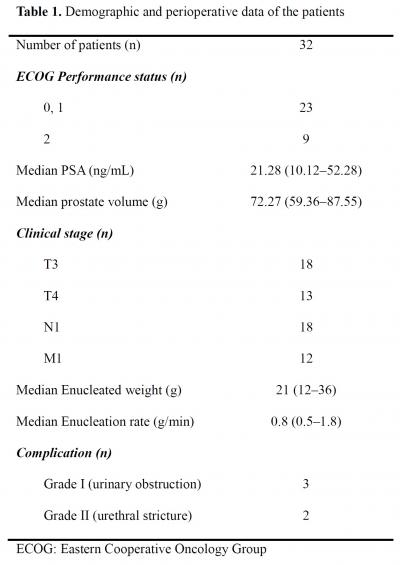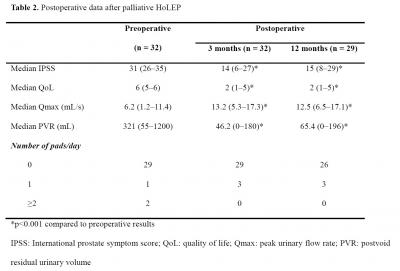|
|
|
방광출구폐색이 있는 진행성전립선암 환자에서 홀뮴레이저를 이용한 전립선 절제술의 효과 |
| 부산대학교병원 비뇨의학교실 |
| 김현우, 김태남, 신동길, 이정주 |
Objectives: This study aims to evaluate the effectiveness of Holmium laser enucleation of the prostate (HoLEP) as a palliative management in advanced prostate cancer (PCA) patients with severe bladder outlet obstruction (BOO).
Materials & Methods: Data of 32 advanced PCA (≥cT3) patients with severe BOO who underwent palliative HoLEP was retrospectively reviewed. Pre- and postoperative (3 and 12 months) International prostate symptom score (IPSS), quality of life score (QoL), peak urinary flow rate (Qmax), postvoid residual urinary volume (PVR), and number of pads per day were compared to evaluate the effectiveness of palliative HoLEP.
Results: Median age and follow-up period of the patients was 70 years (58–84) and 18 months (5–28). At the time of surgery, 87.50% were managing with androgen deprivation therapy and no one received radiation therapy. Preoperatively, 71.88% of patients experienced acute urinary retention and urethral catheterization was performed in 46.88%. Collapse of surgical plane within the prostate and bladder invasion was found in 46.88% and 65.63% of the patients, respectively. Other demographics, perioperative data, and postoperative complications are described in Table 1. A significant improvement of IPSS, QoL, Qmax, and PVR were observed at 3 and 12 postoperative months (Table 2). Catheter and pad free rate were 100% and 84.38% at last follow-up, respectively.
Conclusions: HoLEP can be a safe and effective palliative treatment in advanced PCA patients with severe BOO despite the destructed surgical plane within the prostate.
|
  |
|
keywords : bladder outlet obstruction, prostate cancer, Holmium laser enucleation of the prostate |
|

